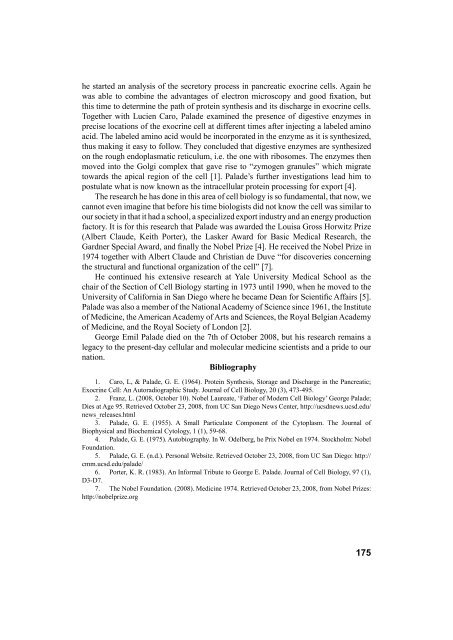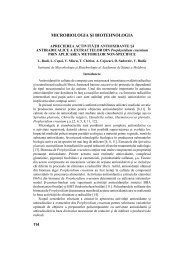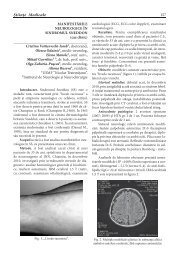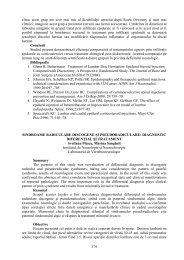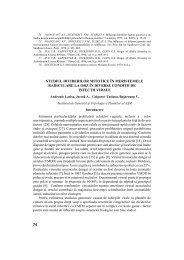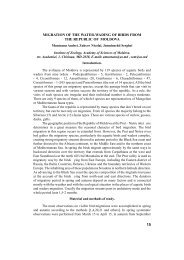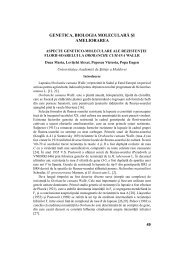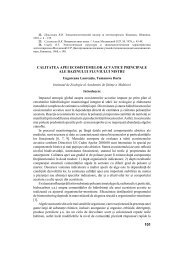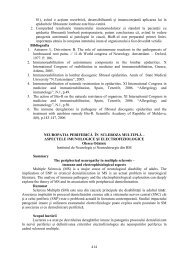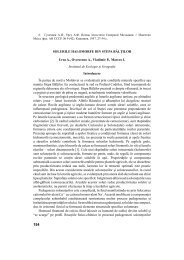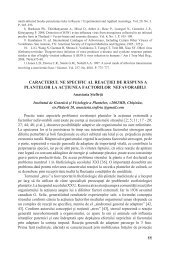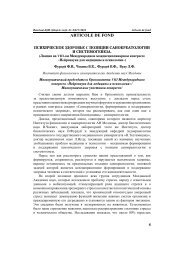198 CUPRINS
198 CUPRINS
198 CUPRINS
You also want an ePaper? Increase the reach of your titles
YUMPU automatically turns print PDFs into web optimized ePapers that Google loves.
he started an analysis of the secretory process in pancreatic exocrine cells. Again he<br />
was able to combine the advantages of electron microscopy and good xation, but<br />
this time to determine the path of protein synthesis and its discharge in exocrine cells.<br />
Together with Lucien Caro, Palade examined the presence of digestive enzymes in<br />
precise locations of the exocrine cell at different times after injecting a labeled amino<br />
acid. The labeled amino acid would be incorporated in the enzyme as it is synthesized,<br />
thus making it easy to follow. They concluded that digestive enzymes are synthesized<br />
on the rough endoplasmatic reticulum, i.e. the one with ribosomes. The enzymes then<br />
moved into the Golgi complex that gave rise to “zymogen granules” which migrate<br />
towards the apical region of the cell [1]. Palade’s further investigations lead him to<br />
postulate what is now known as the intracellular protein processing for export [4].<br />
The research he has done in this area of cell biology is so fundamental, that now, we<br />
cannot even imagine that before his time biologists did not know the cell was similar to<br />
our society in that it had a school, a specialized export industry and an energy production<br />
factory. It is for this research that Palade was awarded the Louisa Gross Horwitz Prize<br />
(Albert Claude, Keith Porter), the Lasker Award for Basic Medical Research, the<br />
Gardner Special Award, and nally the Nobel Prize [4]. He received the Nobel Prize in<br />
1974 together with Albert Claude and Christian de Duve “for discoveries concerning<br />
the structural and functional organization of the cell” [7].<br />
He continued his extensive research at Yale University Medical School as the<br />
chair of the Section of Cell Biology starting in 1973 until 1990, when he moved to the<br />
University of California in San Diego where he became Dean for Scienti c Affairs [5].<br />
Palade was also a member of the National Academy of Science since 1961, the Institute<br />
of Medicine, the American Academy of Arts and Sciences, the Royal Belgian Academy<br />
of Medicine, and the Royal Society of London [2].<br />
George Emil Palade died on the 7th of October 2008, but his research remains a<br />
legacy to the present-day cellular and molecular medicine scientists and a pride to our<br />
nation.<br />
Bibliography<br />
1. Caro, L, & Palade, G. E. (1964). Protein Synthesis, Storage and Discharge in the Pancreatic;<br />
Exocrine Cell: An Autoradiographic Study. Journal of Cell Biology, 20 (3), 473-495.<br />
2. Franz, L. (2008, October 10). Nobel Laureate, ‘Father of Modern Cell Biology’ George Palade;<br />
Dies at Age 95. Retrieved October 23, 2008, from UC San Diego News Center, http://ucsdnews.ucsd.edu/<br />
news_releases.html<br />
3. Palade, G. E. (1955). A Small Particulate Component of the Cytoplasm. The Journal of<br />
Biophysical and Biochemical Cytology, 1 (1), 59-68.<br />
4. Palade, G. E. (1975). Autobiography. In W. Odelberg, he Prix Nobel en 1974. Stockholm: Nobel<br />
Foundation.<br />
5. Palade, G. E. (n.d.). Personal Website. Retrieved October 23, 2008, from UC San Diego: http://<br />
cmm.ucsd.edu/palade/<br />
6. Porter, K. R. (<strong>198</strong>3). An Informal Tribute to George E. Palade. Journal of Cell Biology, 97 (1),<br />
D3-D7.<br />
7. The Nobel Foundation. (2008). Medicine 1974. Retrieved October 23, 2008, from Nobel Prizes:<br />
http://nobelprize.org<br />
175


